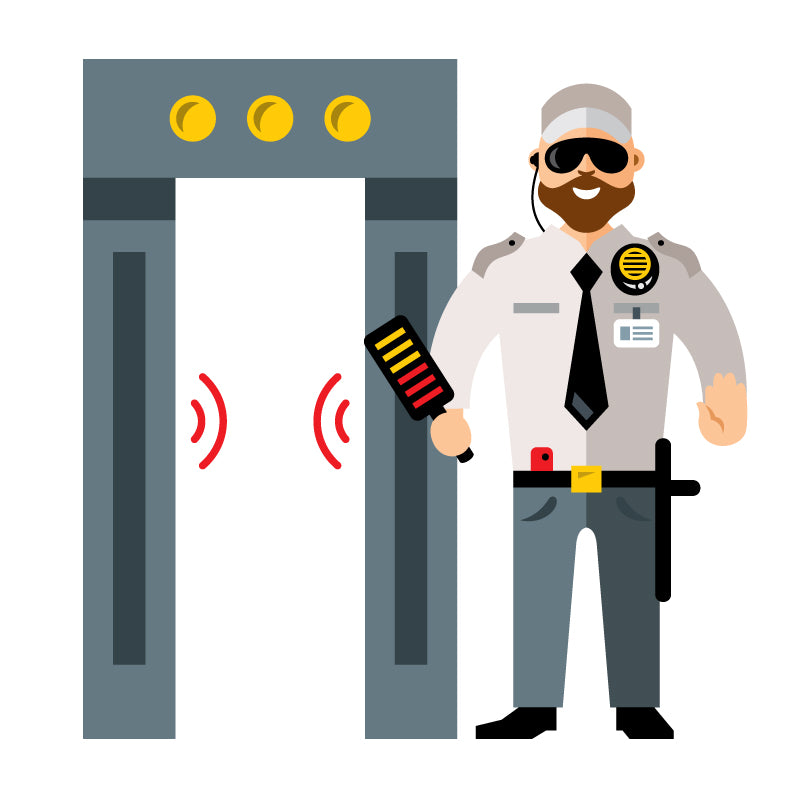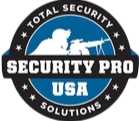
What do airports, amusement parks, and my local county fair have in common? If you guessed overpriced, unhealthy foods (like chocolate covered bacon) then you are partially correct. They also share certain security precautions. Namely, the use of metal detectors at the points of entry, and they are all using these devices to advance occupant safety and mitigate liabilities.
Metal detectors have come a long way in the recent years. They can run the gamut from walkthrough style to handheld and the level of effectiveness has grown by leaps and bounds. In the hands of a trained user, they can be used to identify people, or containers carrying any appreciable metal source. This means detection of weapons such as guns and knives, but also ammunition, cans which might contain toxic or harmful aerosols, and common, improvised impact weapons such as homemade blackjacks, saps, and metal filled or sword canes. Many of these could easily evade detection using even a brisk pat down search. With a metal detector, there is no need to touch the entrant. Simply have them walk through the detector, or wand them with a handheld detector, and you have the means of locating the aforementioned weapons.
How does a metal detector catch metal?
A metal detector uses harmless, electromagnetic induction, in other words, a simple magnetic field, to locate metals. The technology has been around for many years. What has improved is the application of the technology and the compact nature of first rate detectors.
Metal detectors for security use come in a variety of different styles. The two most common types are walkthrough detectors and handheld (wand style) detectors.


Are metal detectors portable?
Both types of metal detectors can be somewhat portable. The handheld style, obviously so. The walk-through metal detectors can either be secured to the ground in a normal fashion, or can be simply placed at an entry point as many are stand-alone items that require only a power source.
Maintenance of metal detectors
Metal detectors do not operate with many moving parts. As such, they require very little in the way of maintenance. For walk-through detectors, ensure the connections for power, or auxiliaries, are clean and well established. For the handheld type, ensure the batteries are up to date, or charged.
When looking for a metal detector, be it walk-through or wand style, the key is to buy from a reputable manufacturer and distributer. Once you have selected the manufacturer, the budget increases will buy more options such as programable detectors which have multi-position fields that can tell you where the metal object is located. Some of the Garrett detectors will also give a count of how many people have passed through. This might be helpful for statistical purposes. It is much like purchasing a quality car. The options don’t increase the quality of the car, just the comfort or level of luxury.
Can you “fool” the metal detector?
Some people ask if the metal detector can “be fooled”. The answer is no. Unless one tried to pass a metal object around the walk-through detector, or some other subrosa action, the metal detector will do its job. The metal detector just uses its magnetic field to detect metal. The security person operating the detector may be fooled if they are not vigilant. Which is one of the drawbacks to a metal detector. The operator may rely on the machine and bypass other security measures or clues. It is important to remember; the metal detector is just another tool in the screening or entry process. The security or Law Enforcement personnel must continue to work in a professional manner and properly screen people.

Metal Detector VS Baggage Scanner
While people bemoan the TSA agents at airports, they have become the de facto experts on implementing metal detectors and entry screening. They simply screen so many people it would be difficult to not become experts. It is interesting to note that most of the weapons or prohibited items TSA finds on passengers, do not come from the metal detectors. They come from carry on baggage screening. The reason for this is that most people now recognize that metal detectors excel at their task. And those people encountering them fully expect that they will not be able to smuggle things on their person. So, they try to pass the items via baggage. Having worked in a closed environment, using metal detectors and x-ray screening, I can confirm this. Metal detectors immediately alert the users to the presence of metal and the need for further investigation. X-ray machines require a keen eye and proper interpretation of the views. Hence, the metal detector requires less training.

How will a metal detector save you money?
It is easy to see how a metal detector will help create a safer environment. How do they save money? Well, in the case of amusement parks and other large public venues, they do so in several ways. For starters, they make the attendees feel more secure, thus increasing the likelihood that people will attend an event. The presence of a metal detector will also be a strong deterrent to weapons smuggling. A single, violent incident in any large-scale public venue would likely draw much negative attention, which could only serve to hurt attendance.
Nowadays metal detectors have different options and capabilities that make them more effective and most importantly, available for various venues and facilities, including schools and other educational institutions. This paired with the current need for extra security at such institutions, makes metal detectors a top security solution.
About the writer
Mike Lazarus
Military and Law Enforcement Veteran
FBI certified firearm instructor
MP5 and Sub Machine gun instructor
Defensive tactics instructor
Police Academy instructor

0 comments